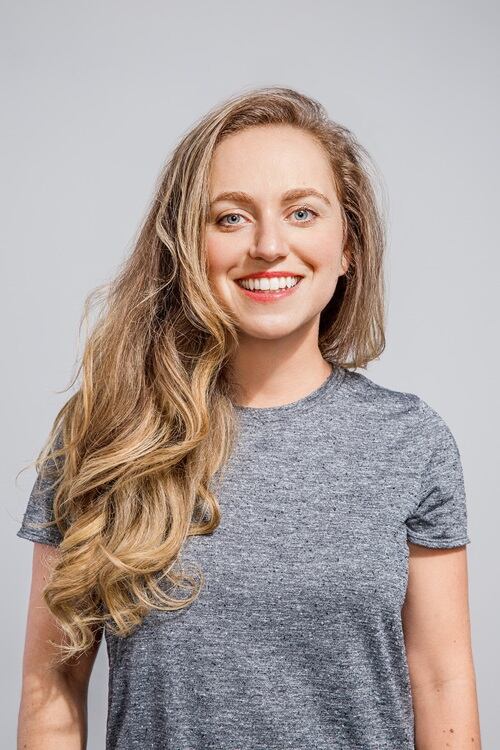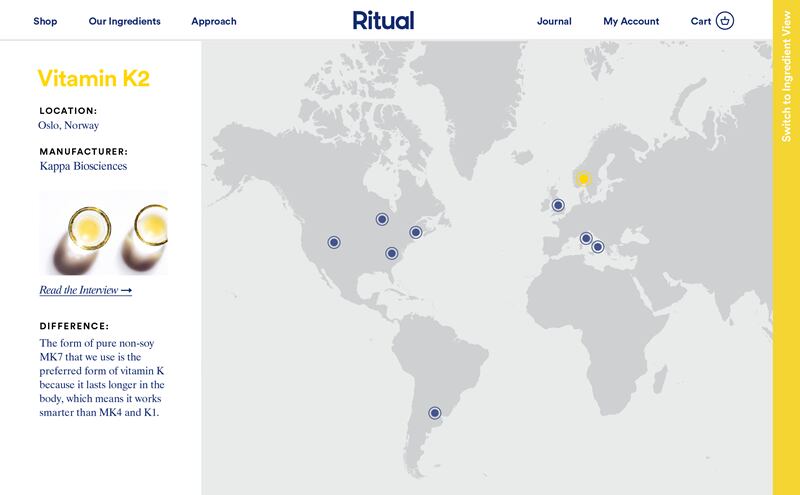The visual effect is made by filling clear gel capsules (vegetarian, made out of hypromellose and gellan gum) with beadlets of its dry ingredients to protect them from the oily ones. In sum, the multivitamin contains vitamin B12, folate, vitamin D3, vitamin K2 MK7, vitamin E, omega-3 fatty acids, boron, iron, and magnesium, dubbed Essential for Women.
As streamlined as the product (it’s the only one they offer) is the business model. Ritual is entirely online and subscription-based, costing subscribers $30 per month (or around 50 cents per capsule for the daily dosage of two per day). Its website acts as a portal for fun content to engage with subscribers, and a place to learn about the suppliers and manufacturers whose ingredients go into each capsule, from Maypro to Gnosis to DSM.
Schneider, who worked as an investor in Los Angeles, thought of creating a simple vitamin after going through the tedious process of researching pre-natal nutrition when she was pregnant two years ago, and realizing many supplements contain ingredients she can’t get behind.
“I called several friends to see what vitamins they were taking,” Schneider told NutraIngredients-USA. “What shocked me was that most people couldn’t remember the brand of vitamins that they’ve been taking for years.”
“Here’s a $30 billion plus industry, and yet there are so many of us who have no idea what vitamins to take [and] what was in vitamins we were taking every day, it just seemed like an interesting opportunity to build a brand,” she added.
Formulated for women, marketed androgynously
Before she took the plunge into the nutrition space, she called on Dr Luke Bucci, a nutraceutical industry veteran with 17 years of research experience with Schiff Nutrition under his belt, to help her design and develop a supplement for women. He now serves as the company’s VP of R&D.

“We determined that there were nine essential nutrients that women were mostly lacking. And it turned out that those nutrient forms could not be found in a typical multivitamin,” she said.
And she assured it’s not ‘pinkwashing’—while many supplements geared for women come in pink containers promoting wellness for hair, skin, or nails, Ritual’s formulation was based on input from researchers and doctors on common nutrition deficiencies among women, not what they think women want.
“I don’t think we’ve built a very feminine brand at all, we’ve built kind of an androgynous brand,” she said. Ritual’s web design and social media aesthetic takes cues from the minimalist typologies now trending in tech, fashion, and architecture.
A muted palette of whites, greys, and blues are interspersed with a pop of yellow here and there—the color of the box that each supplement container is shipped in.
“It turns out women need different things from men—we know that men need less iron and more zinc. If we were to formulate a product for men, it would be different. That being said a lot of our consumers are men, because they haven’t been able to find vitamins like ours on the market,” she said. “It was shockingly surprising.”
Suppliers scratched their heads at first
A hallmark of Ritual’s website is its interactive world map that shows all the sources of its nine nutritional ingredients, down to the name of its manufacturer. They went a step further by including a profile and interview with each supplier.
“It was a confusing request in the beginning,” Schneider said about reaching out to the suppliers not just for their ingredients, but also for their ‘personas’. “We didn’t have the product yet, it was just ideas, and we were like ‘we want to do an interview and talk about your differentiators.’”
“We went deep—once we showed that to the suppliers and the scientists there, they were really excited to partner with us and it’s just radically different,” she added. This marks a huge shift from the ‘proprietary blend’ norm slowly fading away from the dietary supplement industry.

“These ingredients aren’t proprietary to us,” Schneider said. “If some other company wants to use Gnosis’ Quatrefolic folate, by all means they can. Why would we pretend to the consumer that we’ve developed the world’s greatest folate? That’s not what Ritual owns.
It’s a trend Schneider said she picked up from the food industry, as more and more consumers want to know what farm their meat and produce came from as much as about the farmers that raised and harvested them. “I think what consumers care about is understanding their product,” she added.
Social media and a cult-like following
Word of mouth spread like wildfire even before the company first enrolled subscribers in October 2016. The tech-oriented, transparent concept won the interest of many venture capitalists. Propelled by Schneider’s own connection in the VC community, which raised the first million dollars, another $3.5 million was raised in July 2016 by multiple investors, “including Justin Timberlake,” said Schneider.

With the help of outsourced PR, Ritual soon filtered into key media outlets whose audiences match that of Ritual’s target—think New York Times, Vogue, and for a more critical angle, Wired. The final step was to engage consumers and bring in new ones, and that’s where social media kicks in.
“We hope to accomplish a cult-like following,” Schneider said. “What’s really exciting is that people are sharing vitamins for the first time online.” On Twitter, the company got a shout-out from actress Alyssa Milano last month, who organically stumbled upon the company.
But Instagram is the platform Ritual is betting on to engage and expand—the visually-oriented supplement can be seen spilled out on marble table tops or clenched graciously between parted lips covered in a sprinkle of sparkly confetti.
The goal was to make a streamlined, presentable supplement, a step up from the haphazard pill container cocktails of yesteryears. “Before, people would be hiding their vitamins in their vitamin drawers because they’re taking a lot of things,” Schneider said. “We’ve made a fun, simplified vitamin people are really excited about sharing on social media.”
